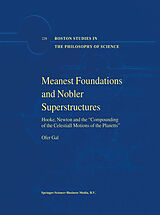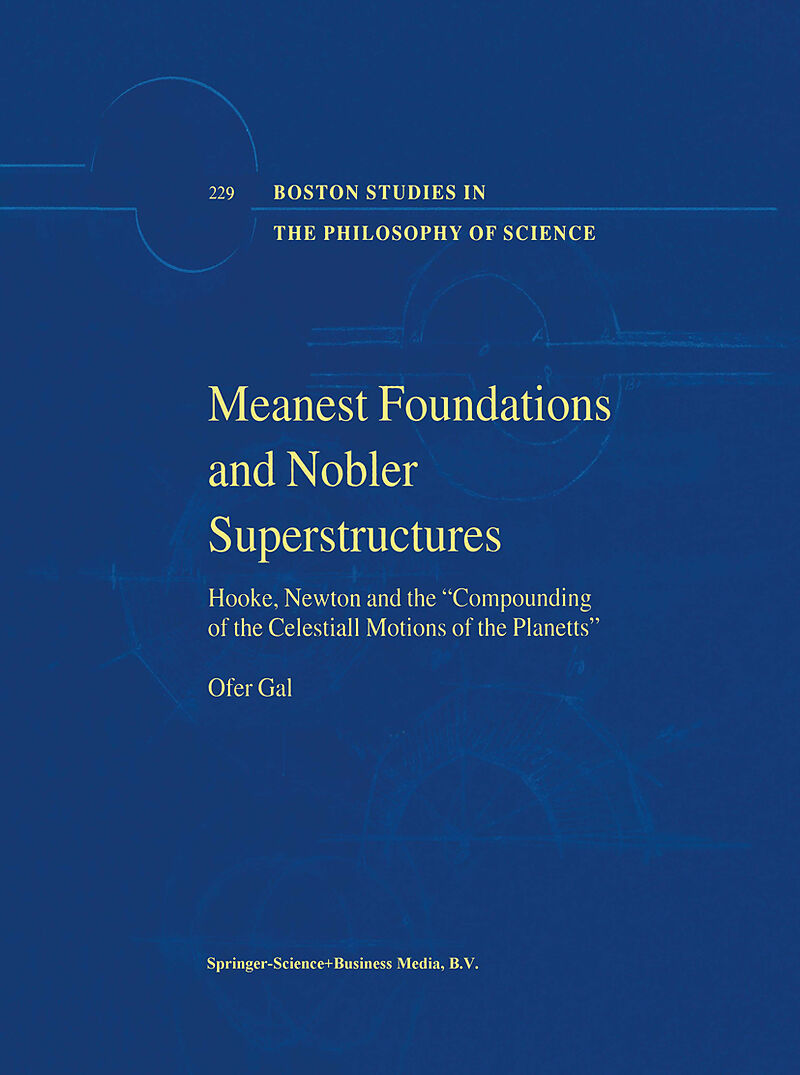Meanest Foundations and Nobler Superstructures
Einband:
Fester Einband
EAN:
9781402007323
Untertitel:
Hooke, Newton and the Compounding of the Celestiall Motions of the Planetts
Autor:
Ofer Gal
Herausgeber:
Springer Netherlands
Auflage:
2002
Anzahl Seiten:
268
Erscheinungsdatum:
31.07.2002
ISBN:
1402007329
This book is a historical-epistemological study of one of the most consequential breakthroughs in the history of celestial mechanics: Robert Hooke's (1635-1703) proposal to "compoun[d] the celestial motions of the planets of a direct motion by the tangent & an attractive motion towards a centrat body" (Newton, The Correspondence li, 297. Henceforth: Correspondence). This is the challenge Hooke presented to Isaac Newton (1642-1727) in a short but intense correspondence in the winter of 1679-80, which set Newton on course for his 1687 Principia, transforming the very concept of "the planetary heavens" in the process (Herivel, 301: De Motu, Version III). 1 It is difficult to overstate the novelty of Hooke 's Programme • The celestial motions, it suggested, those proverbial symbols of stability and immutability, werein fact a process of continuous change: a deflection of the planets from original rectilinear paths by "a centraU attractive power" (Correspondence, li, 313). There was nothing necessary or essential in the shape of planetary orbits. Already known to be "not circular nor concentricall" (ibid. ), Hooke claimed that these apparently closed "curve Line[ s ]" should be understood and calculated as mere effects of rectilinear motions and rectilinear attraction. And as Newton was quick to realize, this also implied that "the planets neither move exactly in ellipse nor revolve twice in the same orbit, so that there are as many orbits to a planet as it has revolutions" (Herivel, 301: De Motu, Version III).
Includes supplementary material: sn.pub/extras
Inhalt
Introduction.- Part A: The Historical Question. 1. Gallileo's Challenge. 2. The Correspondence. 3. Hooke's Programme.- Part B: The Historiographic Difficulty. 4. Hooke vs. Newton. 5. The Genius vs. The Mechanic. 1. Inflection. Introduction: The Bad Ending.- Part A: The Novelty. 1. Hooke's Programme. 2. Setting the Question Right.- Part B: Employing Inflection. 3. Inflection. 4. Application as Manipulation.-- Part C: Producing Inflection in the Workshop. 5. Construction. 6. Implementation. 7. Tentative Conclusion.- 1.st Interlude: Practice. 1. Introduction - Methodological Lessons. 2. Hacking. 3. The Realism Snare. 2. Power.- Part A: 1. Introduction. 2. De Potentia Restitutiva, or: Of Spring.- Part B: 3. Horology. 4. The Spring Watch. 5. Springs and Forces.- Part C: 6. The Origins of the Vibration Theory. 7. Of Spring again. 8. Springs as a Topos. 9. A Clockwork Theory of Matter and Power.- 2.nd Interlude: Representation. 1. Rorty. 2. 'Knowledge Of and 'Knowledge That'. 3. Hacking and Rorty. 3. Newton's Synthesis. 1. Introduction. 2. Newton Before and After. 3. Hooke's Programme. Notes. Introduction. 1. Inflection. 1st Interlude: Practice. 2. Clocks, Pendulums and Springs.- 2.nd Interlude: Representation. 3. Newton's Synthesis.- Bibliography.- Index.

Leider konnten wir für diesen Artikel keine Preise ermitteln ...
billigbuch.ch sucht jetzt für Sie die besten Angebote ...
Die aktuellen Verkaufspreise von 6 Onlineshops werden in Realtime abgefragt.
Sie können das gewünschte Produkt anschliessend direkt beim Anbieter Ihrer Wahl bestellen.
Loading...
Die aktuellen Verkaufspreise von 6 Onlineshops werden in Realtime abgefragt.
Sie können das gewünschte Produkt anschliessend direkt beim Anbieter Ihrer Wahl bestellen.
| # | Onlineshop | Preis CHF | Versand CHF | Total CHF | ||
|---|---|---|---|---|---|---|
| 1 | Seller | 0.00 | 0.00 | 0.00 |
